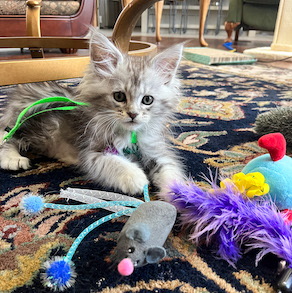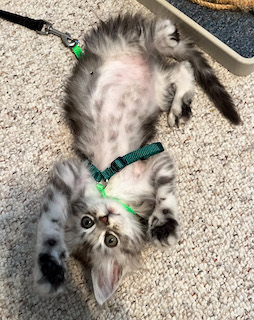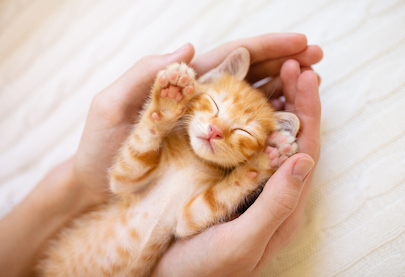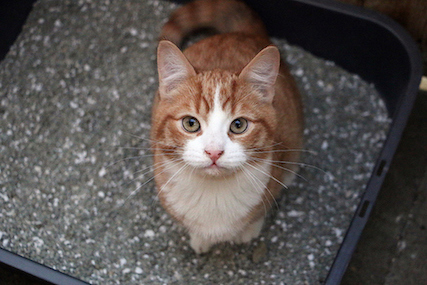
Bringing a new kitten home is an extremely exciting time for the entire family. Pets are the best for giving us a new perspective on life and providing us with endless joy. As a Certified Applied Animal Behaviorist, it’s my goal to make the transition of having a new kitten in your home as easy and stress-free as possible. Below is my complete guide on how to raise a social, happy kitten and what to expect behaviorally. Let’s get into it!
House Setup
Fortunately, litter box training a kitten is much easier than housebreaking a puppy. Cats are naturally clean and have an innate desire to go to the bathroom in private.
When choosing a litter box, select one with low sides so it’s easy for your kitten to get in and out. I recommend using Dr. Elsey’s Attract litter or trying a couple of different litters and see which your cat likes the best. You can place 2-3 different litter boxes with different litter inside and let your cat choose their preference. Line up the litter boxes side-by-side so they are all in the same general area. They should be located in an accessible, private location such as an extra bathroom, basement, closet, or quiet area in the laundry room.
After a few days, remove one extra litter box, and, assuming litter box training is going well, the second litter box can be removed shortly thereafter. The litterbox should always be accessible and the area should not have too much traffic. Cat doors are great to keep other animals out and ensure that your cat has constant access to their litter box.
If you have more than one cat, you should have at least one litter box for each cat plus one. So if you have two cats, you should have three litter boxes. Be sure to scoop the litter box every time your kitten goes potty to start and do a deep clean at least once a month. A clean litter box is key to successful housetraining.

Watch and Confine
During the first few weeks of your kitten’s litter box training, I recommend keeping your kitten in a confined area with the litter box unless you can closely watch them. This gives them fewer options when it comes to making a mistake. When your kitten is more than a few feet away from the litter box, it is important to see if they eliminate elsewhere or make an attempt to go toward the litter box. The goal is to see each time your kitten eliminates, especially if it occurs outside of the litter box.
If you happen to see your kitten use the litter box, wait until they finish and are headed out of the box, then begin praising. I also recommend giving them three small treats for pottying in the box. If you see them having an accident, interrupt the accident with a verbal reprimand. Do this until your kitten is reliably using their litter box, gradually increasing the size of the area they are confined to and the distance from the litter box. Then, they can slowly have full access to the entire home.
Aside from providing the litterbox and water in private and assuming other pets in the home are friendly and respectful of your kitten, other resources should be available in common areas only. Meals, sleeping areas, and cat trees are given around family activities and are provided in common areas like living rooms. I do not recommend offering your kitten their own space away from the household activities. This can encourage hiding and create a less social kitten and in some cases, antisocial behavior. If you want to raise a social kitten, it is best if your home is reflective of this.

The Adoption Process
Just like puppies, kittens learn so much from their littermates and mothers. I recommend waiting to adopt your kitten until they are at least 8 weeks old. This allows them to spend their first few weeks of life with their littermates, learning critical social skills. Ideally, prior to adoption, your kitten is raised in a home with a variety of people and pets. You’ll be well on your way to raising a social kitten if they have many positive experiences with people before coming home with you.
If possible, ask to see the mother cat and other kittens in the litter. Make note of their temperament. A friendly mom and other kittens is a good indicator that your kitten will also have a good temperament. Make sure your kitten’s family is also in good health.
When your kitten first comes home with you, be sure to spend lots of 1:1 time with the kitten. If you adopt multiple kittens, spend individual time with each kitten. This is incredibly important in raising a social kitten. You want to start building a strong, positive, loving relationship with your kitten the second they get home.
Kitten Training
Contrary to popular belief, you can train your cat just like you can train your dog! The first essential piece of kitten training is to teach your kitten to eat out of your hand. Eating out of a hand is not as natural for a kitten as it is for a puppy. If you spend a few minutes each day teaching a kitten to eat out of your hand, it can open up a whole new world for them. It can also be helpful to teach a kitten to eat off of the floor. Cheese or pastes can be smeared close to one another and serve as rewards or help when socializing. You can teach your kitten to come, sit, leash-walking, and shake, the sky’s the limit!

Socialization
Treats can be used to positively reinforce appropriate behavior in kittens. Manners and new behaviors can be easily shaped using food. Maybe even more importantly, treats are incredibly valuable when it comes to socialization. By tapping into classical conditioning, you can take control of your kitten’s early experiences and ensure they are positive. You can start socializing your kitten at 8-9 weeks of age and into early adulthood, targeting the first year and a half of life.
Use treats to make every new experience your kitten has a good one. Every time your kitten is exposed to a new person, object, noise, or pet, give them a treat. For example, you turn on your hairdryer for the first time around your kitten. Give them a treat. Basically, give your kitten a treat around anything you want them to be comfortable with as adults. This will help ensure a happy, confident, and social adult cat.
Handling Your Kitten
Once your kitten is reliably taking treats from your hand, you can start body-handling exercises. Gently touch all of your kitten’s body parts while giving a treat with each touch. Practice picking your kitten up, give them a treat, and put them back down. Gradually increase the time you are holding them for and eventually fade out the treats. These handling exercises are crucial for vet visits, grooming, and overall interactions with humans.

Introducing Your Kitten to Guests
Always give your guests treats first thing when introducing them to your kitten. Get your kitten comfortable with a variety of different people and children. Monitor your guests’ interactions with your kitten and make sure they are handling your kitten with care. Your kitten should never be smothered and should always have the option to leave the situation if they desire. Make sure children let your kitten move freely, avoiding restraint. Restraining a young kitten can begin creating a dislike for being handled.
Make experiences with guests as positive as possible with lots of petting, play, and of course treats. This will ensure your kitten is social with other people, not just you. If you ever have family visiting overnight, your kitten won’t be forced to retreat away from people and will be comfortable hanging out with the whole family. Your home is now your kitten’s home too so you want to make sure they are always comfortable and free of stress.
Vet Visits
Bring your kitten’s favorite treats with you to their first vet visit. This is the time to bring super high-value treats such as meats and cheeses. Once you arrive, scatter treats on the exam table and open your kitten carrier. Allow them to exit the carrier on their own and discover the treats laid out on the table. This helps set the occasion of the veterinary clinic being a great place to visit! Save the highest-value treats for the most difficult times during your visit such as when your kitten receives vaccinations or when the veterinary staff needs to handle them. Continue doing this throughout each visit and you’re kitten will develop into a most loved cat patient!
Introducing Your Kitten to Other Pets

Dogs
When first introducing your kitten to your dog, I recommend having your dog on a leash, assuming they outweigh your kitten by a landslide. Some pet parents feel better about having their kitten wear a collar and dragging a leash as well. If you are by yourself, I recommend having a baby gate in between your kitten and dog. If there is another adult in the house, each adult could be responsible for a respective pet.
Assuming your dog does not have a history of aggression around food or treats, have treats ready for your dog and your kitten. Having treats out for your dog allows the kitten to explore your pup a bit while keeping your dog a bit more distracted. You can tap into classical conditioning and feed your pup in the presence of the kitten to create a strong positive association. The kitten can be fed too but don’t be discouraged if they ignore the treats. Offer treats in high places like a cat tree in the same room as your dog. Your kitten’s meals can be fed in the main living space with your dog present as well.
Other Cats
When first introducing your kitten to other cats in the home, have a barrier in between them such as a baby gate. Feed both your cat and kitten their meals or treats on their respective sides. If there is hissing and aggressive behavior, plan to feed all meals in one another’s presence until the adult cats show friendlier behavior. Once the hissing and aggressive behavior is gone, you can remove the barrier. Continue building positive associations with the new kitten to keep your adult cat happy and stress-free.
By following the tips in this guide, you will be well on your way to having a social, happy adult cat. If you are experiencing any issues with your cat’s behavior or want professional training for your cat, we have in-home cat training programs in Austin, Dallas, Houston, and Kansas City. Schedule a free consultation with our Co-Founder Sean Savage today to get started.
*This page contains Amazon affiliate links. If you choose to purchase after clicking a link, we may receive a commission at no extra cost to you.*




